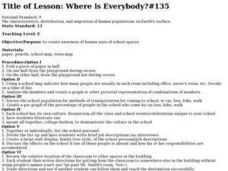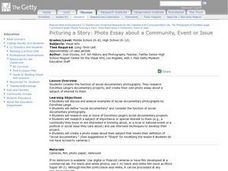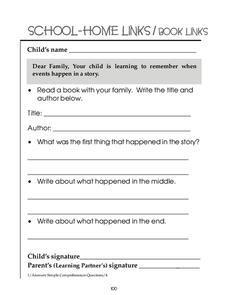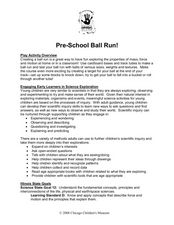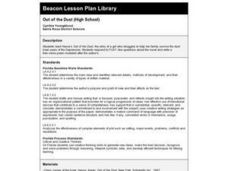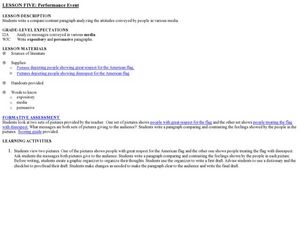Curated OER
Writing a Story: Planning
In this rewriting a familiar story worksheet, students choose a familiar story and fill in the squares of a graphic organizer with new information about the characters, setting, story starter, ending. and/or main events. Students write 5...
Curated OER
Electricity and Magnetism
In this electricity activity, students read and reflect on what electromagnets are and how they attract objects. Students put 4 events in order that would make an electromagnet start attracting objects and identify 3 ways to increase the...
Curated OER
Where is Everybody?#135
Students examine the human uses of school spaces through a variety of activities. They draw the playground during recess and not during recess. They determine how many people use each room at different times before graphing the...
Curated OER
Picturing a Story: Photo Essay About a Community, Event, or Issue
Students research Dorothea Lange's documentary projects and create their own photo essay about a subject. In this photo essay instructional activity, students analyze examples of social-documentary photographs of Lange. Students define a...
Curated OER
Using Current Events to Understand Elections
Eleventh graders explore the the major phases of the electoral process for president. For this US Government lesson, 11th graders compare and contrast the delegate system of nomination and the electoral college.
Curated OER
How Does A Person Cope With Life Changing Events?
Fourth graders explore the concept of conflict mediation. In this coping skills lesson, 4th graders discover conflict mediation skills that may be used to resolve conflict. Students also learn techniques to reduce stress.
Curated OER
Independent - To Be or Not Top Be - Day 2, Lesson 3: In the Course of Human Events
Fifth graders practice scanning skills to answer questions on the French and Indian War.
Curated OER
Probability Of One Event
Pupils investigate the concept of probability. They use example problems in order to measure the likelihood of various outcomes. The instructional activity includes dialogue to be used by the teacher during direct instruction. They also...
Curated OER
Relating Graphs to Events
In this algebra worksheet, students identify the graph that goes with-the equation. They solve word problems using graphs. There are 4 problems with an answer key.
Curated OER
Celebrate National Inclusive Schools Week
Students list traits that make them unique. They participate in a Bingo-like game, where they try to identify people by their traits.
Curated OER
School-Home Links/Book Links
In this reading a book at home worksheet, 1st graders choose a book to read at home with a family member and then write what was the first thing that happened in the story, what happened in the middle and what happened in the end of the...
Curated OER
Pre-School Ball Run
Students demonstrate force and motion by rolling a ball through a tube. In this motion lesson students explore what happens to the ball when it is rolled with other balls of various sizes, weights, and textures.
Curated OER
Defining Citizenship in Recent Events
Students research the rights and responsibilities of citizens and non-citizens living in the U.S. They present a dialogue that showcases their research and take a quiz on the material.
Curated OER
Out of the Dust (High School)
Fourth graders read Hesse's "Out of the Dust". They respond to questions about the novel and write a free-verse poem modeled after the author's.
Curated OER
Performance Event
Young scholars examine the media by writing a compare/contrast paragraph. In this mass communications activity, students identify and discuss the main sources of information for Americans in today's age. Young scholars analyze pictures...
Curated OER
Temperature School
Students observ the cooling and warming of room temperature, hot, and ice cold cans of water by measuring the change in temperature over time. They then attempt to develop explanations for the observations made and apply their findings...
EngageNY
Calculating Conditional Probabilities and Evaluating Independence Using Two-Way Tables (part 1)
Being a statistician means never having to say you're certain! Learners develop two-way frequency tables and calculate conditional and independent probabilities. They understand probability as a method of making a prediction.
EngageNY
Probability Rules (part 2)
Ensure your pupils are rule followers! Learners add the addition rule to the set of probability rules examined in the previous lesson. Problems require both the multiplication and addition rule.
University of the Desert
What Is Extremism?
By participating in discussions using prompts and statements provided in the lesson plan, learners identify the concept of extremism and consider what causes violent acts of extremism in the modern world.
Utah Education Network (UEN)
Probability and Statistics
MAD about statistics? In the seventh chapter of an eight-part seventh-grade workbook series, learners develop probability models and use statistics to draw inferences. In addition, learners play games and conduct experiments to determine...
University of Arizona
Found News Poems
Combine informational text and creative writing with one fun activity! Middle and high schoolers write found poems based on newspaper headlines that they find. The resource includes a thorough lesson plan and many links to articles that...
National Security Agency
Are You Game? A Lesson Connecting Fractions and Probability
Exactly how fair are the board games children grow up playing? Young mathematicians investigate this questions as they work their way through this five-lesson series on basic probability.
Teaching Tolerance
Community Arts Showcase
An art showcase encourages class members to explore the themes of social justice and tolerance. They create an original artwork, engage in group discussions, and journal writing. The art gallery also provides a chance for families and...
Curated OER
Probability - Explore and Tabulate
Upper elementary and middle schoolers explore the concept of probability. In this probability lesson, pupils flip coins and draw chips out of a bag to determine the likelihood of a particular outcome. They perform the experiments with...


